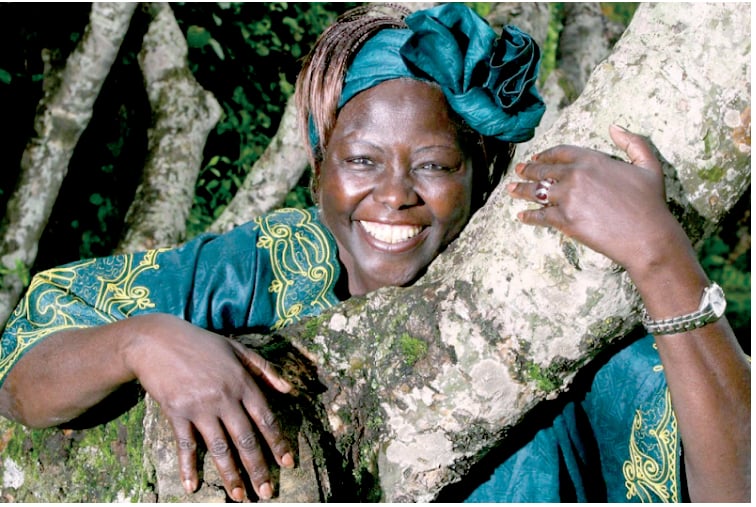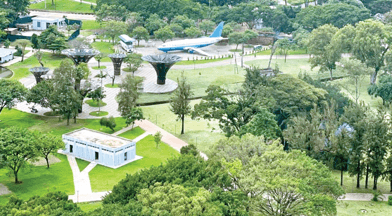Tireless tree-hugger who uprooted mighty cartels

In October 1989, Wangari Maathai learned of a plan to construct the 60-storey Kenya Times Media Trust Complex in Uhuru Park, whose artist’s impression we had duly published on the front page of that day’s edition of the Kenya Times.
The complex was intended to house the headquarters of Kanu, the Kenya Times newspaper, a trading centre, offices, an auditorium, galleries, shopping malls and parking spaces for 2,000 cars.
It also included a large statue of Moi.
Wangari wrote many letters of protest to the Kenya Times, the Office of the President, the Nairobi City Commission, the Provincial Commissioner, the ministers for environment and natural resources, internal security and public works, the UNEP and UNESCO executive directors, and the British High Commissioner Sir John Johnson.
Crazy woman
Wangari urged the envoy to intervene with Robert Maxwell, a British citizen and major shareholder in the project. She equated the construction of a tower in Uhuru Park to putting up such a structure in Hyde Park or Central Park, maintaining that it would not be tolerated.
“When I see Uhuru Park and contemplate its meaning, I feel compelled to fight for it so that my grandchildren may share that dream and that joy of freedom as they one day walk there,” she wrote.
The government refused to respond to her inquiries and protests, instead responding through the media that Wangari was “a crazy woman”, that denying the project in Uhuru Park would take more than a small portion of public backlash, while proclaiming the project as a fine and magnificent work of architecture opposed by only the “ignorant few”.
On November 8, 1989, Parliament expressed outrage at her actions, complaining of her letters to foreign organisations, and calling the Greenbelt Movement (GBM) a bogus organisation and its members a bunch of “divorcees”. They suggested that if Wangari was so comfortable writing to Europeans, perhaps she should go live in Europe.
Despite Wangari’s clear and popular protests, the ground was broken on November 15, 1989. She sought an injunction in the High Court to halt construction but the case was thrown out on 11 December. The next day on Jamhuri (Independence) Day, at the venue of the proposed project – Uhuru Park, Moi stated that those who opposed the project had “insects” in their heads.
Moi suggested that Wangari be a proper woman in the African tradition, respect men and be quiet. She was forced by the government to vacate her office, and the GBM was moved into her home. The NGO was audited in an apparent attempt to shut it down.
Despite the government’s efforts, her protests and media coverage of the government’s response led to the foreign investors abandoning the project in January 1990.Wangari had won her first major environmental and political battle against the powerful and mighty.
Maxwell’s team of managers and editors who had joined the Kenya Time Media Trust partnership would soon jump ship, unable to withstand interference from State House in the running of the newspaper. I have personal recollections of the many times calls from “above” came, seeking to know the newspaper’s contents, mostly the next day’s front page splash.
Maxwell himself, led a flamboyant lifestyle despite being embroiled in litigation and controversy, often flying in his helicopter from his Oxford home, or sailing in his luxury yacht, the Lady Ghislaine, named after his daughter Ghislaine Noelle Marion. After the Nairobi debacle, he had to sell successful businesses to cover some of his debts.
In 1991, just one year after his botched venture with Moi and Kanu and the epic battle with Wangari Maathai, his body was discovered floating in the Atlantic Ocean, having apparently fallen overboard form his yacht.
Maxwell’s death triggered the collapse of his publishing empire. Large discrepancies in his companies’ finances were revealed, including his fraudulent misappropriation of the Mirror Group pension fund.
His daughter Ghislaine, a former British socialite and convicted sex offender was found guilty of child-sex trafficking and other offences in connection with the deceased financier Jeffrey Epstein in 2021. She was sentenced in a federal court in New York to 20 years’ imprisonment in 2021.
Her partner Epstein, also a child sex trafficking offender, died in his jail cell on August 10, 2019 of suspected suicide disputed by his lawyers. Trump’s Attorney-General Pam Bondi last Thursday released government documents related to Epstein that to-date is the subject of intrigues, conspiracy theories and a list of prominent personalities in high places associated with him.
Back to Kenya and a year after Maxwell’s death in January 1992, it came to the attention of Wangari Maathai, now an active anti-establishment politician and other pro-democracy activists that a list of people was targeted for assassination and that a government-sponsored coup attempt was possible. Her name was on the list.
The pro-democracy group known as the Forum for the Restoration of Democracy (FORD) was at the forefront of the second liberation struggle, the introduction of multi-party politics in Kenya and free and fair elections. They were also targeted for arrests. Fearing arrest, Wangari barricaded herself in her house and was besieged for three days before police cut through the bars she had installed on her windows and arrested her.
She and the other arrested pro-democracy activists were charged with spreading malicious rumours, sedition and treason. The government would later in November drop the charges after pressure from many international organisations and eight US senators including former Vice President Al Gore and Edward M. Kennedy.
Earlier on February 28, 1992, while out on bail, Wangari and others, including mothers of 52 political prisoners -among them students, journalists, lawyers, and human rights activists- detained by the government took part in a hunger strike at a corner in Uhuru Park thy labelled Freedom Corner, across from the infamous Nyayo House torture chambers, to pressure the government to release the political prisoners.
Ultimate curse
After four days of hunger strike, on March 3, 1992, the day Kenyans marked yesterday, 33 years later, the police forcibly removed the protesters. Wangari and three others were knocked unconscious by police and hospitalised.
The attack drew international criticism. The US State Department said it was deeply concerned by the violence and by the forcible removal of the hunger strikers. President Moi called Wangari Maathai a mad woman and a threat to the order and security of the country.
Mothers of the political prisoners, in an unprecedented act of defiance and protest, performed the ultimate Africa curse – stripping to their skin. To ward off the police, two of the protesting mothers stripped their clothing and dared the police to kill them, shouting: “What kind of government is this that beats women. Kill us now! Kill us now. We shall die with our children! Their action resulted in the brutal police turning away and leaving the scene in shame. The mothers regularly participated in several actions related to the release of their sons and by 19 January, all of the mothers were united with their sons. The mothers’ heroic act came to an end in January 1993 with the release of the last political prisoners, ending forever the streak of political imprisonments in Kenya.
It also led to the 1992 constitutional amendment that reduced the presidential term to a maximum of two terms and repeal of all the oppressive laws including the Public Order Act, the Chief’s Authority Act and the Sedition Law.
According to Wangari Maathai, the tactic of disrobing was particularly effective in stopping the police because “in the African tradition, people must respect women who are close to their mother’s age, and they must treat them as their mothers. If men beat mothers, it is like sons violating their mothers, and the mothers respond by cursing them. And they cursed them by showing them their nakedness”.
Celebrating the mothers’ act and Wangari Maathai is a celebration of various milestones achieved in the political emancipation achieved since February1992 that built up the momentum culminating in the new people’s Constitution in August 2010.
The striking mothers won much support for their cause. Transportation workers boycotted work in protest because of the harassment of the mothers. Large crowds of stone-throwing demonstrators were dispersed by police firing tear-gas.
The next day the mothers regrouped to continue their campaign at the All Saints Cathedral after the government prohibited them from returning to Freedom Corner. Then Provost Peter Njenga granted them sanctuary.
I had the opportunity of interviewing Wangari Maathai at the hallowed grounds of the church during which she narrated her conviction for the liberation of all Kenyans, democracy, the protection of human rights and environmental conservation.
On the evening of April 1, police raided the All Saints Cathedral and occupied the grounds for three days as the mothers barricaded themselves in the church bunker.
On April 12, the late Archbishop of the Anglican Church Manasses Kuria declared that “idlers” were officially barred from the cathedral grounds, and that the cathedral was a sanctuary for the mothers of the political prisoners.
Wangari Maathai was given due recognition with several international awards including the Nobel Peace Prize in 2004. She also continued with other colleagues in the pro-democracy push but despite their efforts, a fractured Opposition (FORD) led to Moi and Kanu retaining power in the 1992 elections.
She continued her environmental work with the GBM, notably in 1998 when she learned of a government plan to privatise large areas of public land in the Karura Forest, where she went, planted trees and pretested the destruction of the forest.
On January 8, 1999, a group of protesters including Wangari, six Opposition MPs, journalists, international observers, and GBM members and supporters returned to the forest to plant a tree in protest when they were attacked. Many of the protesters were injured, including Wangari, and four MPs, some of the journalists and German environmentalists.
She reported the incident but the police refused to return to the forest to arrest the attackers. The event provoked international outrage. Students broke out and some were broken up by police. Protests continued until August 16, 1999 when
President Moi bowed to pressure and announced that he was banning all allocation of public land.
In 2001, the government again planned to take public forest land and give it to its supporters. Wangari protested and was arrested on March 7, 2001 but released without charge following popular and international protest at her arrest. On July 7, 2001, shortly after planting trees at Freedom Corner in Uhuru Park, to commemorate Saba Saba Day, she was again arrested and released without being charged.
In January 2002, she went to teach at Yale University’s School of Environmental Studies until June 2002 when she returned to Kenya and campaigned for Parliament in the 2002 elections as a candidate for the National Rainbow Coalition (NARC), which defeated Kanu, ending its 40-year stranglehold of authoritarian power in Kenya.
She won the Tetu parliamentary constituency seat. In January 2003, she was appointed Assistant Minister for Environment and Natural Resources until November 2005.
Wangari Maathai was awarded the Nobel Peace Prize in 2004 for her contribution to sustainable development, democracy and peace. She was the first African woman and environmentalist to win the prestigious award. Between 1901 and 2018, only 52 Nobel Prize awards have been given to women, and 852 to men.
This remarkable achievement is enough reason to grant her the enduring accolade of a true Kenyan legend who courageously stood up against environmental destruction and political oppression in Kenya – recognised nationally and internationally as an inspiration in the fight for democracy and protection of people and planet.















